| Columns Retired Columns & Blogs |
Sonus Faber Amati Homage anniversario loudspeaker Measurements
Sidebar 3: Measurements
Like its predecessor, the Amati anniversario was significantly more sensitive than average, at an estimated 91.2dB(B)/2.83V/m, within experimental error of the specification. However, the speaker demands quite a lot of current from the amplifier, with an impedance that remains below 6 ohms for almost all the audioband and drops to 3 ohms for much of the midrange (fig.1). There is also a combination of 3.8 ohms magnitude and –50° at 68Hz, a frequency where music can have considerable bass energy. This phase angle at higher frequencies is otherwise quite low, but this speaker still needs to be partnered with an amplifier unfazed by high current.
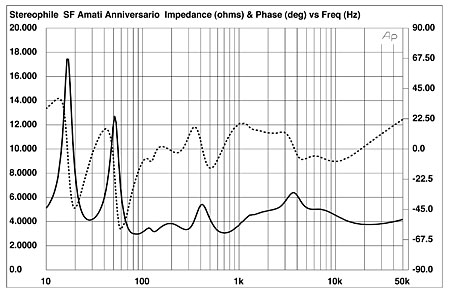
Fig.1 Sonus Faber Amati anniversario, electrical impedance (solid) and phase (dashed). (2 ohms/vertical div.)
The traces in the impedance graph are free from the small discontinuities that would imply the presence of panel resonances, though there is a peculiar bump in the magnitude trace between 100Hz and 150Hz. Listening to the cabinet walls with a stethoscope while I played the half-step–spaced toneburst track on my Editor's Choice CD (Stereophile STPH016-2), I could hear some low-level problems both around the C above middle C (512Hz) and an octave higher. Fig.2 is a cumulative spectral-decay plot calculated from the output of an accelerometer fastened to the sidewall of the speaker 12" from the top. A single mode can be seen at 1050Hz, a frequency where it will be unlikely to have audible consequences. However, I could hear a whistle in this same frequency region emanating from the upper port. The cabinet walls were otherwise well behaved, though a similar plot calculated from the accelerometer's output when it was fastened to the top panel found a low-level ridge of delayed energy at 121Hz (not shown).
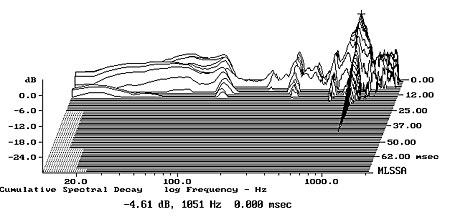
Fig.2 Sonus Faber Amati anniversario, cumulative spectral-decay plot calculated from the output of an accelerometer fastened to the cabinet's side panel 12" from the top (MLS driving voltage to speaker, 7.55V; measurement bandwidth, 2kHz).
The saddle at 28Hz in fig.1 suggests that this is the tuning frequency of the lower of the two ports on the rear of the cabinet, which loads the two woofers. However, while the woofers have a notch at this frequency that is slightly wider than usual (the red trace to the left of fig.3 shows the sum of the woofer outputs), the port's response (fig.3, blue trace) has a wider-than-expected bandpass and is too low in level to fully extend the speaker's LF response, at least under anechoic conditions. Suspiciously, the response of this port has a peak at 120Hz, which coincides both with a discontinuity in the woofer's output and with the impedance anomaly noted earlier. The black trace below 300Hz in this graph is the complex sum of all the low-frequency outputs. The midbass peak will be partly due to the nearfield measurement technique, which assumes a 2pi acoustic environment. Anechoically, the speaker's low end will extend to 35Hz or so before rolling off with rather a slower slope than a typical reflex design.
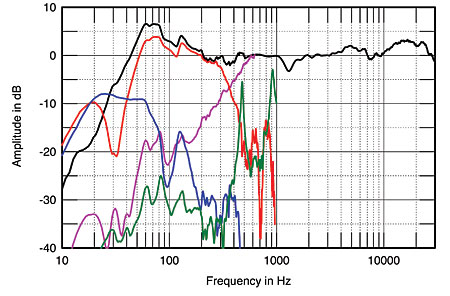
Fig.3 Sonus Faber Amati anniversario, anechoic response on listening axis at 50" without grille, averaged across 30° horizontal window and corrected for microphone response, with the nearfield responses of the midrange unit (magenta), woofers (red), lower port (blue), upper port (green), and their complex sum (black).
The green trace in fig.3 shows the response of the upper port, scaled, like all these nearfield responses, in the ratio of the square root of the radiating area. It doesn't appear to do much at all at low frequencies. However, it has two large peaks present in its midrange output, obviously the source of the whistling I heard. Fortunately, the port faces away from the listener, reducing the audibility of these resonant modes. I suspect that this behavior has something to do with the hardness I thought I heard at high levels. The port, of course, can be blocked, but there is still something amiss in the cabinet's internal construction.
The magenta trace in fig.3 shows the nearfield response of the midrange unit, which crosses over to the woofers at 350Hz—higher in frequency than in the original Amati. Other than a small notch at 1.2kHz and a very slight rising trend through the treble, the farfield response, averaged across a 30° horizontal angle on the listening axis (fig.3, black trace above 300Hz), is commendably flat. The responses in fig.3 were taken with the grille off. Fig.4 shows the effect on that response of the grille. The grille introduces the expected comb filtering due to the reflections of the sound from the vertical fibers, but the amplitude of the resultant peaks and dips remains between moderate ±1.5dB limits.
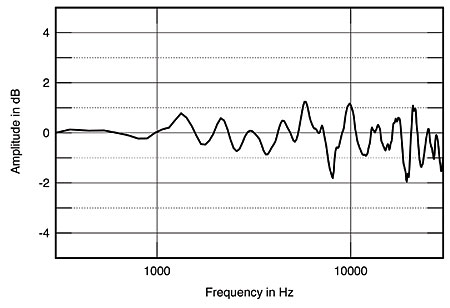
Fig.4 Sonus Faber Amati anniversario, effect of grille on listening-axis response (2dB/vertical div.).
A flat on-axis response cannot guarantee a speaker's balance being perceived as flat without taking into account its radiation pattern. The Amati's horizontal dispersion is shown in fig.5. Other than a slight off-axis flare in the bottom octave of the tweeter's passband, it is impressively wide and uniform. As usual, the tweeter gets directional above 10kHz, but not quite to the extent that I've found with other speakers using versions of this ring-radiator unit. In the vertical plane (fig.6), a deep suckout at 3.9kHz develops immediately above the tweeter axis (third trace from the top), this presumably the crossover frequency between the midrange unit and the tweeter. The Amati's response doesn't change by much below the tweeter axis, confirming that raking the baffle back is the right setup strategy.
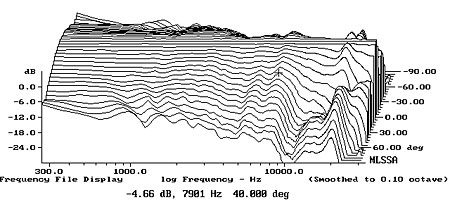
Fig.5 Sonus Faber Amati anniversario, lateral response family at 50", normalized to response on listening axis, from back to front: differences in response 90–5° off axis, reference response, differences in response 5–90° off axis.
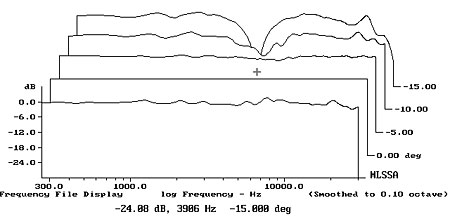
Fig.6 Sonus Faber Amati anniversario, vertical response family at 50", normalized to response on listening axis, from back to front: differences in response 15–5° above axis, reference response, difference in response 5° below axis.
The proof of a speaker's measured behavior, of course, is in the listening room. Fig.7 shows the Amati's spatially averaged response at my listening position. The graph meets superbly flat ±1.2dB limits between the 500Hz and 10kHz 1/3-octave bands, and the bass is extended and even. The middle of the midrange is suppressed a little, however, presumably due to the interactions between the drive-units and the room boundaries; this, together with the extended high frequencies, is probably why I felt the Amati's balance was on the forward side in my room. In a larger room, or one with more sound-damping treatment, the speaker's balance will be nigh on neutral.
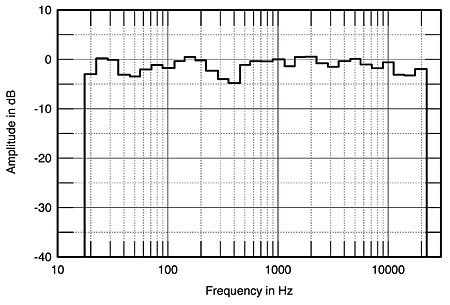
Fig.7 Sonus Faber Amati anniversario, spatially averaged, 1/3-octave response in JA's listening room.
Turning to the time domain, the Sonus Faber's step response on the listening axis (fig.8) indicates that all its drive-units are connected in positive acoustic polarity, this confirmed by examining the step responses of the individual drivers (not shown). Ignore the bump at the 7ms mark in this graph, which is due to the reflection of the speaker's sound from the floor between it and the microphone; I could not lift the Amati onto my usual high stand for the acoustic measurements. I windowed out this reflection to produce both the response curves and the speaker's cumulative-spectral-decay plot (fig.9). This is superbly clean, with just a small amount of delayed energy coinciding with the slight notch at 1.2kHz in the on-axis response. No wonder I felt the speaker's upper frequencies sounded so grain-free and natural.
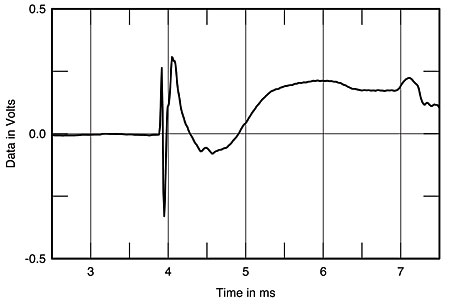
Fig.8 Sonus Faber Amati anniversario, step response on listening axis at 50" (5ms time window, 30kHz bandwidth).
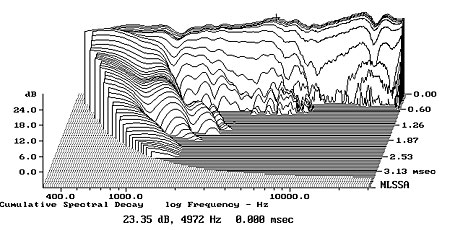
Fig.9 Sonus Faber Amati anniversario, cumulative spectral-decay plot at 50" (0.15ms risetime).
Other than that lively upper port, the Sonus Faber Amati anniversario gets a clean bill of health, measurement-wise.—John Atkinson
- Log in or register to post comments




































